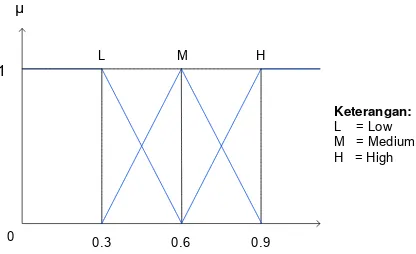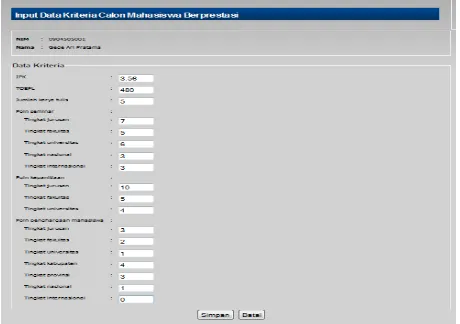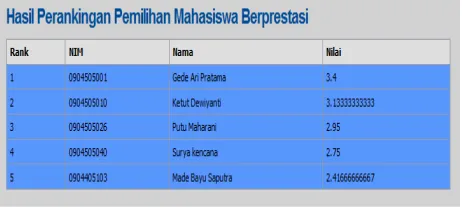Analysis and Implementation Fuzzy Multi-Attribute
Decision Making SAW Method for Selection of High
Achieving Students in Faculty Level
Widayanti-Deni1, Oka-Sudana2 and Arya-Sasmita3
1
Department of Information Technology, Udayana University Bali, 80361, Indonesia
2
Department of Information Technology, Udayana University Bali, 80361, Indonesia
3
Department of Information Technology, Udayana University Bali, 80361, Indonesia
Abstract
This paper we provide an overview of the analysis and implementation a method of decision-making system for high achieving students selection. The method used is Fuzzy Multi-Attribute Decision Making (FMADM) Simple Additive weighting (SAW). FMADM SAW itself is a method of decision-making that uses a simple weighting system. The use of this method is expected to help and provide the best decision in the selection of high achieving students in the faculty level.
Keywords: Criteria, FMADM, SAW, weight, high achieving students.
1. Introduction
Decision-making in the selection of high achieving students requires data processing time given the number of students are owned by a college and not a little to be completely in accordance with the conditions set. The process of selecting high achieving students must be precise, accurate and quality to be able to achieve the expected outcome is to get students achievement appropriate to their criteria or standards set. But the process of selecting and processing data of participants sometimes still use manual techniques that will require a longer time in both data processing and transmission of results.
Along with current technological developments that can be addressed with the establishment of a system that can help the Faculty of Engineering, Udayana University in the decision-making by using a Decision Support System (DSS) in which this system provides the facility to do an analysis so that each process decisions made based on existing criteria. The method used in this research is to use models of Fuzzy Multi-Attribute Decision Making (FMADM), Simple Additive Weighting Method (SAW).
The research is expected to provide convenience and efficiency of data processing in the selection of high achieving students in faculty level.
2. Methodology
Overview of Fuzzy SAW method the selection high achieving students in faculty level can be seen in Fig 1.
Criteria student
Fuzzy Multiple Attribute Decision Making
(FMADM)
Suitability rating value
Value priorities (W)
Decision matrix (X) Result of selection
Fuzzy SAW Method
Normalization matrix (R)
Calculations of V Ranking
2.1
Fuzzy
Multi-Attribute
Decision
Making
approach of subjective, objective approach and the approach to the integration between the subjective and objective. Each approach has advantages and disadvantages. In the subjective approach, the weights are determined based on the subjectivity of decision-makers par, so that some of the factors in ranking the alternatives can be determined independently. While the objective approach, the weights are calculated mathematically that ignoring the subjectivity of the decision makers [4].There are several methods that can be used to solve the problem FMADM namely [3]:
1. Simple Additive Weighting (SAW) 2. Weighted Product (WP)
3. ELECTRE
4. Technique for Order Preference by Similarity to Ideal Solution (TOPSIS)
5. Analytic Hierarchy Process (AHP)
2.2 Simple Additive Weighting (SAW) Method
Churchman and Ackoff (1945) first utilized the SAW method to with a portfolio selection problem. The SAW method is probably the best known and widely used method for multiple attribute decision making MADM. Because of its simplicity, SAW is the most popular method in MADM problems [2].
SAW method also known as the term is often weighted summation method. The basic concept of SAW method is to find a weighted sum of rating the performance of each alternative on all attributes. SAW method requires a process of normalizing the decision matrix (X) to a scale that can be compared with all the rating of the alternatives.
� =
is used if the attribute/criteria is benefit
Minixij
xij is used if the attribute/criteria is cost
Where rij is the normalized performance ratings of alternatives Ai on attributes Cj, i = 1,2, ..., m and j = 1,2, ..., n. Preference value for each alternative (Vi) is given as:
� = � �
2.2.1 Step Completion SAW Method
This research uses a model FMADM SAW method. The steps are [3]:
Step 1: Determining the criteria that will be used as a reference in decision-making, namely Ci.
Step 2: Determine the suitability rating of each alternative on each criterion.
Step 3: Making decisions based on criteria matrix (Ci). Step 4: Normalized matrix equations based tailored to the type attribute (attribute or attributes benefit costs) to obtain normalized matrix R.
Step 5: The final results obtained from the ranking the sum of normalized R matrix multiplication with the weight vector in order to obtain the greatest value is selected as the best alternative (Ai) as a solution.
3. Requirement Analysis for FMADM SAW
Method
The criteria taken into consideration in the selection of high achieving students as in Tables 1.
Table 1: Criteria selection of high achieving students
No Criteria
1 Grade Point Average / GPA 2 TOEFL Score
3 Number of paper that ever made
4 Number of seminars / workshops have been followed
5 Number of committees have been followed Department level
6 Number of award-owned
High achieving student criteria listed above each have six criteria where there are some criteria that have high levels of valuation. Each level is the criteria that have to be multiplied first by their respective weights in Table 2 for total points of each of these criteria.
non-academic assessment based on active students in campus activities such as committees and seminars / workshops.
Table 3: Criteria of high achieving students (Ci).
Each criterion will be defined as a priority assessment weighting (W) selection high achieving students. The weight consists of five fuzzy numbers such as Very Low
Fig. 2 Overview of fuzzy linguistic variables of the weight for each criterion
The weights of each criterion for the selection of high achieving student are as follows:
Table 4: Priority assessment weighting (W)
Criteria C1 and C3 consists of four fuzzy numbers are
Fig. 3 Overview of fuzzy linguistic variables for criteria GPA (C1) and number of paper (C3)
Table 5: Fuzzy linguistic variables and their correspondent fuzzy number for GPA (C1)
GPA (C1) Linguistic terms Linguistic values
GPA < 2,51 Very Low 0.25
GPA 2,51-3,00 Low 0.5
GPA 3,01-3,50 Medium 0.75
GPA > 3,50 High 1
Table 6: Fuzzy linguistic variables and their correspondent fuzzy number for Number of paper (C3)
Number of paper (C3) Linguistic terms Linguistic values Number of paper < 3 Very Low 0,25 Criteria Name of criteria
C1 Grade Point Average/GPA
C2 TOEFL Score
C3 Number of paper that ever made C4 Point of seminars/workshops have been
followed
C5 Point of committees have been followed
Number of paper 3-5 Low 0.5
Number of paper 6-10 Medium 0.75
Number of paper > 10 High 1
Criterion C2 consists of five fuzzy numbers are Very Low (VL), Low (L), Medium (M), High (H) and Very High
Fig. 4 Overview of fuzzy linguistic variables for criteria TOEFL Score (C2)
Table 7: Fuzzy linguistic variables and their correspondent fuzzy number for TOEFL Score (C2)
TOEFL Score (C2) Linguistic terms
Fig. 5 Overview of fuzzy linguistic variables for criteria point of seminars/workshops (C4), point of committees (C5), and point of
award-owned (C6)
Table 8: Fuzzy linguistic variables and their correspondent fuzzy number for Point of seminars/workshops (C4)
Point of
Table 9: Fuzzy linguistic variables and their correspondent fuzzy number for Point of committees (C5)
Point of committees (C5) Linguistic terms
Linguistic values
Point of committees < 21 Low 0.3
Point of committees 21-40 Medium 0.6
Point of committees > 40 High 0.9
Table 10: Fuzzy linguistic variables and their correspondent fuzzy number for Point of award-owned (C6)
Point of award-owned (C6) Linguistic terms
Linguistic values
Point of award-owned < 21 Low 0.3
Point of award-owned 21-40 Medium 0.6 Point of award-owned > 40 High 0.9
4. Implementation and Results
Referring to high achieving students data tables described above may be formed suitability rating each alternative on each criterion.
Table 11: Suitability rating
Decision matrix (X):
The example of normalization matrix calculations:
then the results obtained normalization matrix (R):
�=
1 0.75 0.67
0.75 1 1
0.75 1 0.67
1 1 1
0.67 1 0.33
0.67 1 0.33
0.75 0.5 0.67
1 0.5 1
1 1 0.33
1 1 0.67
Weights:
W=
Veryhigh; High; Medium; Verylow; Low; High
W= 1; 0.8; 0.6; 0.2; 0.4; 0.8
The example of V calculations for the ranking:
�1 = 1 1 + 0.8 0.75 + 0.6 0.67 + 0.2 1 + 0.4 1 + 0.8 1
= 1 + 0.536 + 0.402 + 0.2 + 0.4 + 0.8
= 3.338
Based on calculations using those calculations, the greatest value is in V1 so that A1 could feasibly be used as the best alternative in selecting of high achieving students. Here are the final results in tabular form.
Table 12: Assessment result
Rank Alternative Value
1 A1 3,338
3 A2 2,948
4 A3 2,886
5 A4 2,416
2 A5 3,136
4.1 Implementation in System
In the Fig. 6 is a display system for inputting form high achieving students criteria values where some criteria had levels as described in Table 1.
Fig. 6 Overview input criteria form.
The user fills in the form with the value of each criterion and the system will process these values in accordance with the calculation method FMADM SAW. Here's the view from each of the outcome of the calculation on Fig. 7, Fig. 8, and Fig. 9.
Fig. 7 Overview data of suitability rating value.
Fig. 9 Overview data of matrix R.
After processing system to search each value V will then be shown the results of the value of V for each of the attributes that have been sorted by the largest value of V as shown in Fig. 9. Thus it can be determined that students with student ID (NIM) 0904505001 selected as high achieving students.
Fig. 10 Overview of assessment result selection of high achieving students.
5. CONCLUSION
Based on the research that has been done, it can be concluded that the FMADM SAW method can be used in the selection process of high achieving students. The selection results obtained in the form of ranking the final value of the participant. Although using a simple weighting calculations, FMADM SAW method can provide the best decision in the decision process.
Acknowledgments
Our thank goes to Department of Information Technology Udayana University, Bali, who has helped organize this research.
References
[1] Dikti, “Pedoman Mahasiswa Berprestasi Program Sarjana”, Jakarta, 2011
[2] Huang. Jeng. Jih, “Multiple Attribute Decision Making Methods and Applications”, Chapman and Hall/CRC, 2011
[3] Kusumadewi. Sri, Hartati. S, Harjoko. A, and Wardoyo. R, “Fuzzy Multi-Attribute Decision Making (FUZZY MADM)”, Yogyakarta: Graha Ilmu, 2006
[4] Kusumadewi. Sri, “Diktat Kuliah Kecerdasan Buatan, Jurusan Teknik Informatika”, Fakultas Teknologi Industri Universitas Islam Indonesia, 2007
[5] S. Wibowo. Henry, Amalia Riska, M. Fadlun. Andi,
and Arivanty. Kurniawan, “Sistem Pendukung Keputusan Untuk Menentukan Penerima Beasiswa Bank BRI Menggunakan FMADM (Studi Kasus: Mahasiswa Fakultas Teknologi Industry Universitas Islam Indonesia)”, National Conference: Seminar Nasional Aplikasi Teknologi Informasi (SNATI), 2009
[6] Modarres, M., Sadi-Nezhad. “Fuzzy Simple Additive Weighting Method By Preference Ratio”, Intelligent Automation and Soft Computing, Vol. 11, No. 4, 2005, pp. 235-244
[7] Rumaisa. Fitrah and Nurafianti. Tanti, “Sistem Pendukung Keputusan Kelulusan Ujian Saringan Masuk Jalur PMDK Berdasarkan Nilai Rata-Rata
Matematika dan Bahasa Inggris”, National
Conference: Design and Application of Technology, 2010
[8] Putra. Apriansyah and Hardiyanti. Yunika. Dinna,
“Penentuan Penerima Beasiswa dengan Menggunakan Fuzzy MADM”. National Conference: Seminar Nasional Informatika (semnasIF). 2011
AUTHORS PROFILE
Made Widayanti Deni is a student at Faculty of Engineering,
Department of Information Technology, Udayana University. Her research interest on decision support system for selection of high achieving students to get her bachelor degree.
A.A Oka Kompiang Sudana. S.Kom, MT received his S.Kom
I Gusti Made Arya Sasmita, ST, MT received his ST. degree in




